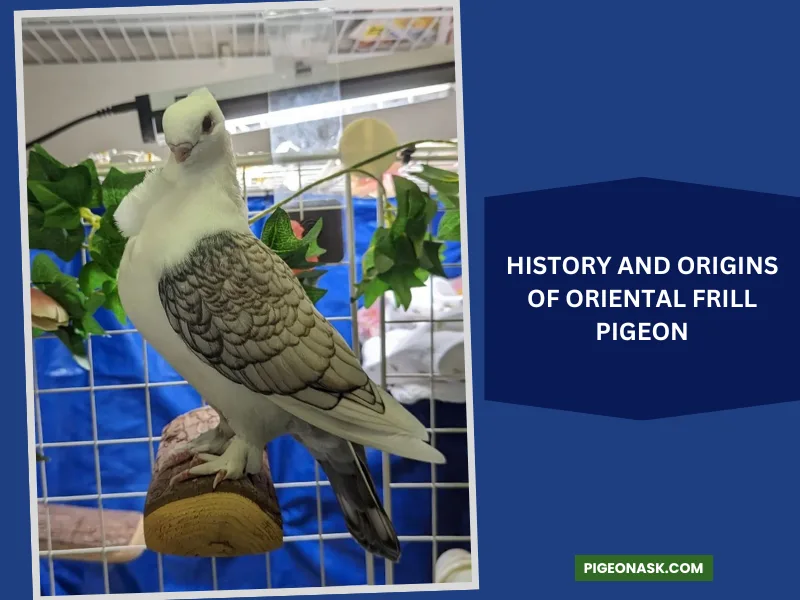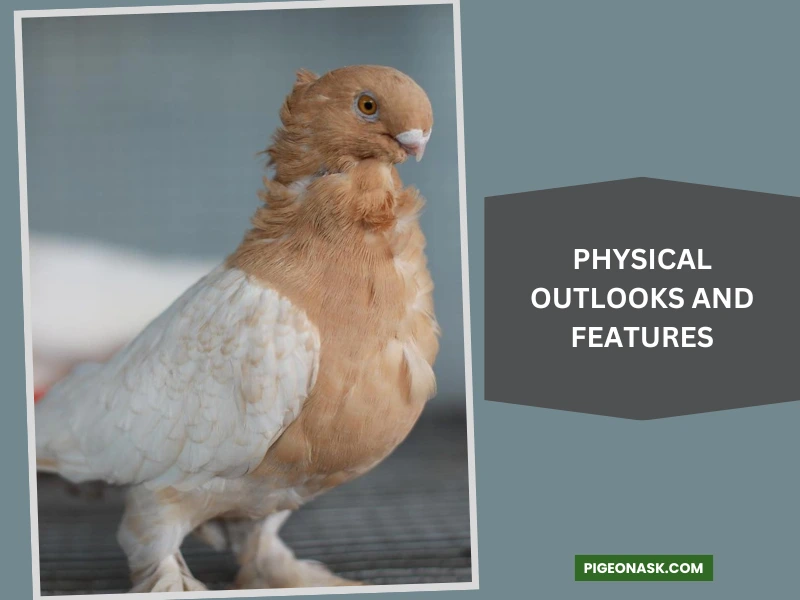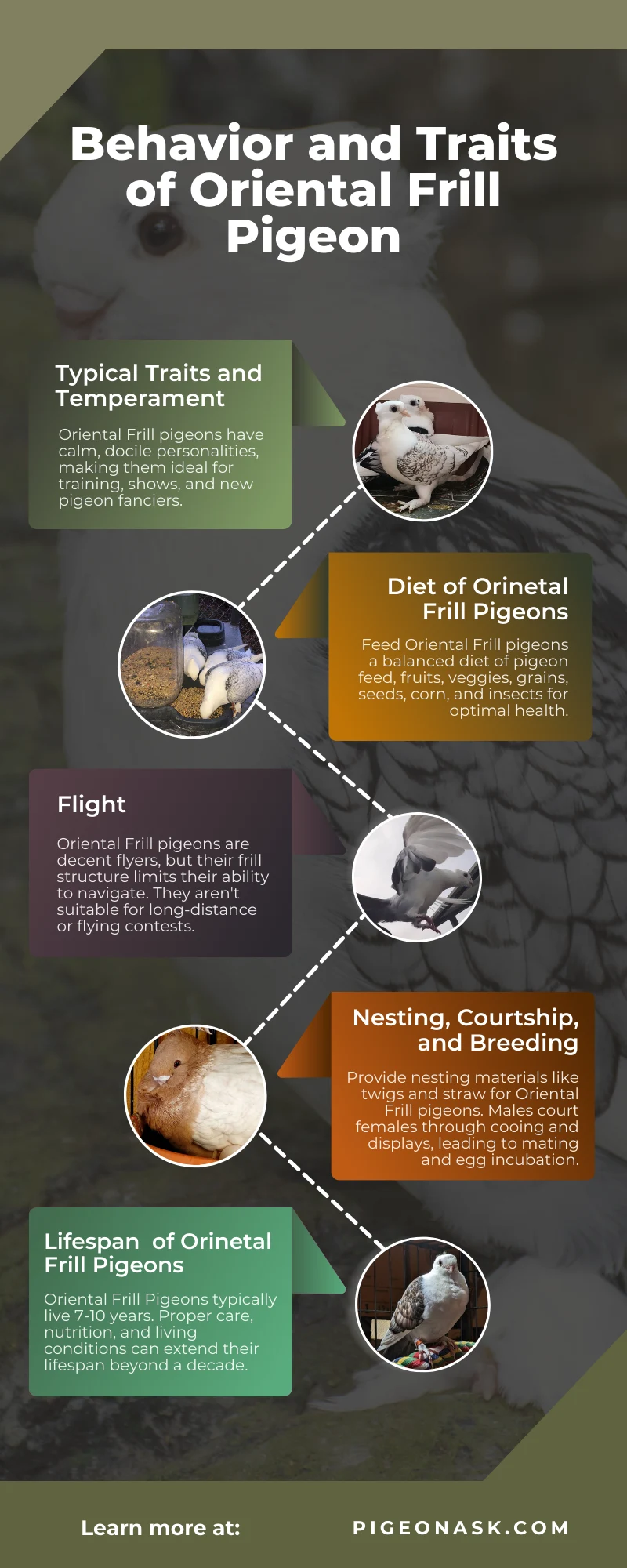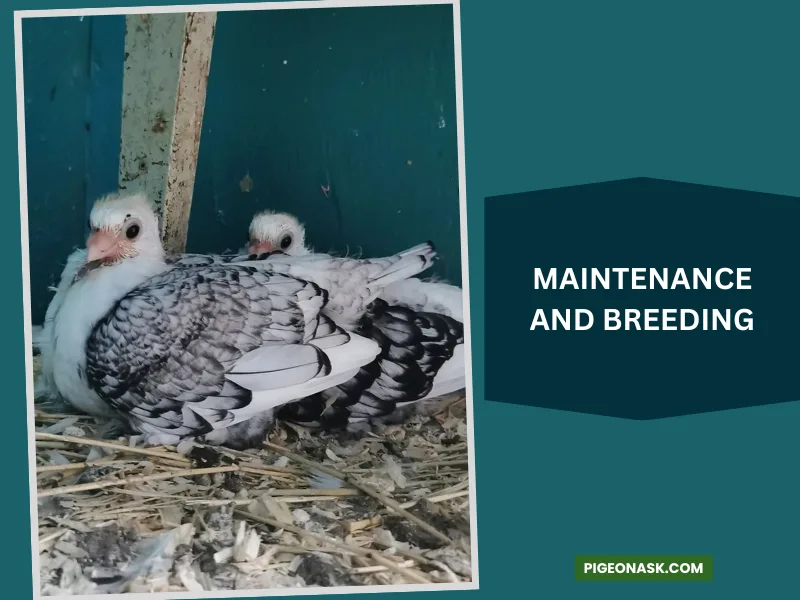Oriental Frill Pigeon: Behavior And Breed Guide
Few birds are as good-looking as the Oriental Frill pigeon. This pigeon has it all. They’re beautiful, easy to raise, and have a quiet personality that makes them incredible pets.
First developed in Turkey, the Oriental Frill pigeon is a fancy breed of birds with many variations, like the Blondinettes and Satinettes.
In this article, you will learn all about it, as well as many tips to help you breed them successfully.
Oriental Frill Pigeon Profile
| Name | Oriental Frill Pigeon |
|---|---|
| Scientific Name: | Columba livia |
| Common Names: | Hünkari |
| Origin: | Turkey |
| Size: | 33 Cm |
| Weight: | 310 – 340 Grams |
| Lifespan: | 7 – 10 Years |
| Physical Features: | Compact body, round head, short beak, large eyes, broad breast, firm wings |
| Temperament: | Calm |
| Behavior: | Docile |
| Special Features: | Feathers on neck and shoulders |
| Breeding and Maintenance: | Hassle-free |
| Common or Popular Varieties: | Blondinettes, Santinettes, & others |
Looking for more articles about pigeon breed:
Overview
The Oriental Frill Pigeon is a fancy bird primarily developed for show, exhibition, and competition. While this bird has average flight ability, it’s not a suitable breed for racing.
Nonetheless, a docile nature makes the Oriental Frill fun to raise and have as pets.
History and Origins of Oriental Frill Pigeon
This type of fancy pigeon resulted from selective breeding and years of development.
Originally, it’s a bird first developed in Turkey, with the sole purpose of entertaining the Ottoman Sultans. For this reason, the Turkish call this pigeon Hünkari.

Many varieties of this pigeon exist, but the most common are the Blondinettes and Satinettes.
Blondinettes have nearly total colored feathers, saving the shoulders and wings. On the other hand, Satinettes are mostly white, and only the wings are of different colors.
Physical Characteristics and Features
This breed of pigeons has different bodily features that make it unique and stand out. Here’s how you can identify these birds.
Body Structure, Size, and Weight
Oriental Frill pigeons are birds of medium size (33cm), usually weighing between 310 and 340 grams. The body of this bird is compact, featuring a rounded head and a short, broad beak.

Additionally, the eyes of these birds are big and round. They have a short neck, broad breast, and sturdy wings.
Unique Features
The most distinctive feature of the Oriental Frill pigeon is a set of feathers covering its neck and chest. These feathers form a unique pattern, almost similar to a lace collar.
Likewise, the color of this particular trait often varies. They can be white, black, red, or many other varieties.
Behavior and Traits of Oriental Frill Pigeon
Learn all about the Oriental Frill pigeon’s behavior, personality, and personality to ensure you provide comfortable living conditions for them.

Common Personality Traits and Temperament
Oriental Frill pigeons are famous for their quiet personality, calm temperament, and docile behavior.
These traits allow these birds to get along with humans, allowing pigeon fanciers to train them for exhibition and show purposes without complications.
If you wonder if this pigeon breed is appropriate for new fanciers, the answer is yes.
Diet
The ideal diet for this pigeon shall consist of pigeon feed with fruits and veggies. These ingredients will help the pigeon’s nutrition, allowing it to grow healthy.
Likewise, you can include typical pigeon food like grains, seeds, corn, and insects.
Flight
The Oriental Frill pigeon is a good flyer, but its flight capacity is not remarkable. Typically, these birds have a frill composition that complicates their ability to navigate midair.
As a result, this bird is not ideal for flying long distances or for flying contests.
Nesting, Courtship, and Breeding
Oriental Frill pigeons like to create a comfortable nest environment as their resting place.
Ideally, you must provide materials like twigs, leaves, straws, leaves, and even clothes to help them make a nest. If you do, the chances of a successful breeding will be higher.
The courtship between the Oriental Frill pigeons begins when the male starts to look after the female. In due time, the male will coo and use body displays like showing their chests to attract the female.
This action gets the female’s attention, pairing up with the male to mate.
After breeding, the female will incubate the eggs for a couple of weeks before the offspring hatch.
Lifespan
The average lifespan of an Oriental Frill Pigeon is between seven and ten years. How long this pigeon lives depends on proper maintenance, healthy feeding, and living conditions.
Under the right conditions, these birds will live a healthy life for over ten years.
Maintenance and Breeding
The Oriental Frill pigeon does not require complicated maintenance tasks. Generally, you should only clean their living space to avoid accumulating droppings, food waste, and other harmful elements.

Some Tips and Considerations for Successful Breeding
- Choose an ideal pair, and preferably a flock. Start breeding Oriental Frill pigeons by choosing a selection of healthy birds from a renowned provider.
- Look for physical features, like bright eyes and spotless feathers.
- Create a comfortable living space to guarantee the pigeons are comfortable and do not deal with stress.
- Check the pigeons to prevent illnesses, looking for issues like appetite loss, breathing problems, or other ailments.
- Keep track of the clutches of eggs, as the pigeons could produce several per year.
- Don’t breed the pigeons too often, or they will suffer stress.
- Avoid inbreeding to prevent genetic problems by separating related birds.
Housing Requirements
Pigeon fanciers use different housing styles to raise Oriental Frill pigeons.
For example, you can create large aviaries or lofts with nesting boxes included.
This combination is good because the pigeons will have more space to socialize and fly. Furthermore, you could make their living conditions more enjoyable by adding perches, ropes, and swings.
Final Word
The Oriental Frill pigeon is a fun breed to raise for many reasons. This bird is easy to handle, doesn’t require complicated care or maintenance, and they’re docile pets, too!
Plus, these birds can learn many tricks to put up great shows and exhibitions.
Found this article interesting? We constantly share informative pieces about pigeons, birds, and much more on our socials! Stay connected with us on Twitter, Facebook, and Pinterest to keep up!
